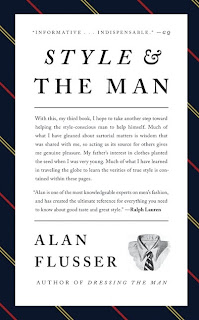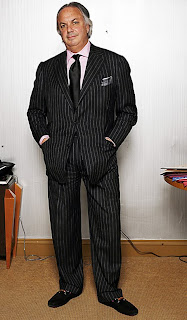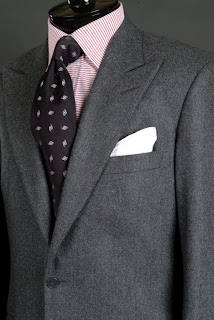 I was recently in New York City, meeting with Alan Flusser, with whom I will be working on an exciting and significant project, and was given an advance copy of Style & The Man. The book, which is an updated and trimmed down re-release of the seminal sartorial guide, hit the shelves this week and I have to say, it’s good to have Mr. Flusser back.
I was recently in New York City, meeting with Alan Flusser, with whom I will be working on an exciting and significant project, and was given an advance copy of Style & The Man. The book, which is an updated and trimmed down re-release of the seminal sartorial guide, hit the shelves this week and I have to say, it’s good to have Mr. Flusser back.
It’s an excellent guide for anyone looking to get a better understanding about the sometimes intimidating world of tailored menswear. More so, it’s also an invaluable resource when it comes to explaining what to look for in your clothes, how they should look on you and how you should feel in them.
The book is a fresh take on the first half of the original Style & The Man – an outstanding tome in its own right. He’s dispensed with the extensive shopping guide that comprised the original’s second half, but in reality nothing is lost. What we are left with is a straightforward guide on dressing well, fully updated for life in 2010. It’s a trim, easily portable volume of 137 pages that’s packed with great advice.
As Alan told me, “this book is one resource that men can go to and get a reasonably logical and fact based perspective on dressing well. In this era of designer and opinion driven fashion, the world is not, at the moment, overstocked in materials or academia devoted to the style aspiring consumer.”
 That “Alan Flusser” is the byword for sartorial exceptionalism is really not a surprise once you spend some time with him. More than any other menswear authority, he understands the mechanics of personal style. Skin tone, hair color, eye color, face shape, body type and even your neck height, all play a significant role in finding the right colors, patterns and styles that work for you. What about your physique – are you short or tall, heavy or trim?
That “Alan Flusser” is the byword for sartorial exceptionalism is really not a surprise once you spend some time with him. More than any other menswear authority, he understands the mechanics of personal style. Skin tone, hair color, eye color, face shape, body type and even your neck height, all play a significant role in finding the right colors, patterns and styles that work for you. What about your physique – are you short or tall, heavy or trim?
Once you understand your own profile, you know what to look for when you hit the mall, or, you know, the bespoke tailor should you be feeling flush. Alan has spent his life studying the unique role that color and proportion play in how clothing affects the wearer. There is a reason Ralph Lauren says he’s one of the most knowledgeable experts on men’s fashion.
 “Much like golf or tennis, dressing is a skill that can be taught and learned,” says Alan. In Style & The Man he discusses things like what to look for in shirts, shoes and neck wear, and explains the importance of fit and the keystone role of your shoulders. He illuminates the reader about seemingly obscure topics like why lapel width matters and clarifies larger issues such as the long-term value of a bespoke suit.
“Much like golf or tennis, dressing is a skill that can be taught and learned,” says Alan. In Style & The Man he discusses things like what to look for in shirts, shoes and neck wear, and explains the importance of fit and the keystone role of your shoulders. He illuminates the reader about seemingly obscure topics like why lapel width matters and clarifies larger issues such as the long-term value of a bespoke suit.
Did you know that good foot wear and a hand rolled pocket square can make any outfit look better; do you know why? This is the practical yet elusive advice that makes a real difference. This book probably belongs in every man’s library, even if he thinks he doesn’t need it. Especially if he thinks he doesn’t need it!
Great news! I loved the original and can't wait to see this new version.
ML
mlanesepic.blogspot.com
Bravo, finally an article of substance. Much better than that rubbish you wrote regarding J. Crew. Keep it up please.
Flusser? Who is this man Flusser?
ADG – Ha, good one. You are, without a doubt, THE man.
Anon – Glad you liked the article, though I think you might be a little biased against the mass' love of Ivy League casual. It's always good to have a balance of formal and informal, costly and less so, bespoke and OTR. It's what keeps life interesting.
Regardless, thanks very much for being a reader.
Does he really think he dresses well?? His pants are incredibly long and although I'm not a purist about wearing slipons with a suit- I actually like it- those loafers just look awful paired with a suit.
Who does he think he is… REALLY!
I just ordered the book. I'm looking forward to giving it a read. Thanks for giving us a preview.
Once you understand your own profile, you know what to look for when you hit the mall, or, you know, the bespoke tailor should you be feeling flush. Alan has spent his life studying the unique role that color and proportion play in how clothing affects the wearer.